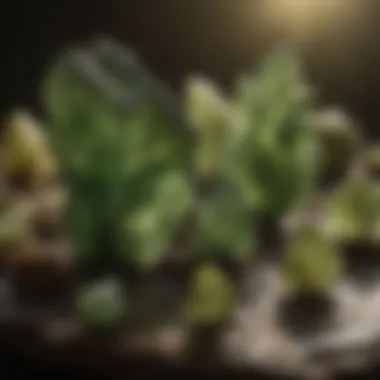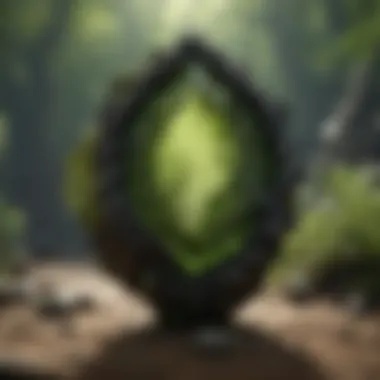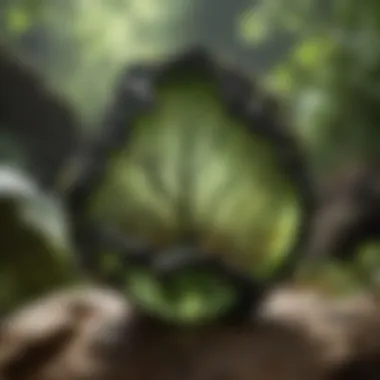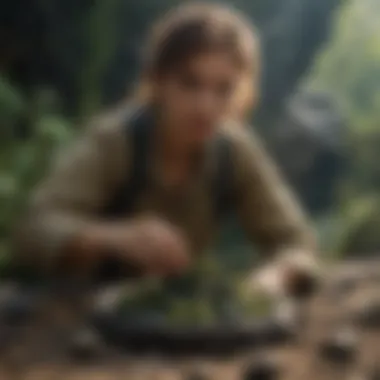Where to Find Moldavite: A Detailed Guide for Rock and Fossil Collectors


Geological Insights
Exploring the geological insights behind moldavite adds a layer of fascination to the collecting experience for rock and fossil enthusiasts. Moldavite originates from unique geological formations that involve the fusion of meteorite impacts with terrestrial rocks, resulting in the creation of this prized gemstone. Its scarcity and geological processes make moldavite a valuable addition to any collection, often carrying historical significance due to its celestial origins.
Throughout history, moldavite has sparked notable discoveries in the field of geology and paleontology, shedding light on Earth's deep past and connection to outer space. By understanding the geological formations and processes that give rise to moldavite, collectors gain a deeper appreciation for this extraordinary gemstone and its place in the vast tapestry of Earth's geological history.
Introduction
In the realm of rock and fossil collecting, Moldavite stands out as a truly unique and captivating geological specimen. This introduction serves as the gateway to a comprehensive guide dedicated to providing enthusiasts with a deep dive into the world of Moldavite. As a highly sought-after item, understanding Moldavite is essential for collectors looking to expand their knowledge and add rare pieces to their collection. This article aims to shed light on the origins, properties, procurement methods, authenticity considerations, pricing trends, and care tips related to Moldavite. By delving into these aspects, readers will gain valuable insights that cater to both novice enthusiasts and seasoned collectors.
What is Moldavite?
Moldavite, a prized possession in the realm of geology, is a unique form of tektite, resulting from a meteorite impact around 15 million years ago. This olive-green translucent gem is often sourced in the areas of southern Germany, Austria, and the Czech Republic. What sets Moldavite apart is its intriguing formation process, wherein terrestrial material fused with extraterrestrial matter to create this stunning gemstone. With its distinct appearance and ethereal origins, Moldavite holds a special place in the hearts of rock and fossil collectors seeking one-of-a-kind specimens to add to their collection.
To understand Moldavite is to unravel a tale of cosmic collisions and geological metamorphosis. Its rarity and ancient lineage make it a prized possession among collectors worldwide, garnering admiration for its unique origins and celestial connection.
Origins of Moldavite
Moldavite, a cherished geological gemstone, holds immense significance for rock and fossil collectors due to its intriguing origins. The topic of Origins of Moldavite within this comprehensive guide delves into the geological processes that led to the formation of this unique specimen. Understanding the backstory of moldavite is crucial for collectors as it provides insights into its rarity and value in the world of geology and gemology.
Formation Process
The formation process of moldavite is a fascinating journey that dates back millions of years. Moldavite is believed to have originated from the impact of a meteorite striking the Earth, specifically the region of southern Germany. This impact resulted in immense heat and pressure, melting the surrounding rocks and creating the distinctive green glass-like substance known as moldavite. The fusion of extraterrestrial and terrestrial elements during this cataclysmic event produced a material unlike any other, making moldavite a prized and sought-after gemstone among collectors.
Locations
Moldavite is primarily found in the southern region of Germany, particularly around the Ries crater where the meteorite impact occurred. Additionally, moldavite deposits can also be located in regions of the Czech Republic, where fragments of the gemstone have been discovered. These areas serve as primary sources for moldavite procurement, attracting collectors and enthusiasts from around the world due to the stone's limited availability and unique origins.
Significance in Geology
In the field of geology, moldavite holds significant importance as a natural glass formed by the fusion of meteoric material and terrestrial components. Its origins link back to celestial events, making it a prized specimen for studying impact processes and the interaction between space and Earth. Geologists value moldavite not only for its rarity but also for the insights it provides into past cosmic events that have shaped the geological landscape of our planet.


Properties of Moldavite
In this article, delving into the properties of moldavite is vital to understanding its allure and significance. Moldavite, a unique geological specimen formed by celestial impact, possesses distinct characteristics that sets it apart from other minerals. Its striking green color, often ranging from pale green to deep forest hues, is a result of its composition which includes silicon dioxide and aluminum oxide. This composition gives moldavite its glassy texture and lightness, making it a prized addition to any rock or fossil collection.
Furthermore, the properties of moldavite extend beyond its visual appearance. It is believed to possess powerful metaphysical properties, with some enthusiasts considering it a stone of transformation and spiritual growth. Its unique energy is said to help in clearing negative energies and promoting overall well-being. These metaphysical properties add a layer of mystique to moldavite, making it a coveted gemstone among those interested in crystal healing and alternative therapies.
Additionally, collectors and enthusiasts must consider the rarity and authenticity of moldavite when assessing its properties. Due to its limited supply and increasing demand, genuine moldavite can be quite valuable, urging buyers to be cautious of counterfeit or synthetic imitations in the market. Therefore, understanding the properties of moldavite is crucial for ensuring that collectors make informed decisions when acquiring this prized gemstone.
Physical Characteristics
Exploring the physical characteristics of moldavite allows collectors to appreciate its unique nature in detail. Moldavite typically exhibits a tektite morphology, featuring aerodynamic curves and folds that result from its high-velocity impact formation. Its surface may display intricate patterns, often resembling ripples or grooves, adding to its aesthetic appeal.
Moreover, moldavite's texture is smooth and glass-like, with occasional bubble inclusions that further enhance its beauty. These bubbles, known as gas vesicles, are remnants of the meteoritic impact that created moldavite millions of years ago. The presence of these inclusions can help distinguish authentic moldavite specimens from synthetic or treated versions.
When examining moldavite, collectors should also observe its specific gravity, refractive index, and fluorescence under ultraviolet light. These physical characteristics provide valuable insights into the identity and quality of moldavite, aiding collectors in differentiating between genuine specimens and artificial replicas.
Where to Find Moldavite
In the expansive world of rock and fossil collection, the search for moldavite holds a special place. Understanding where to find moldavite is crucial for enthusiasts seeking to add this unique geological specimen to their collection. The significance of this topic within the context of this comprehensive guide lies in enlightening readers about the various avenues through which they can acquire moldavite.
When delving into the realm of where to find moldavite, several specific elements merit attention. Firstly, the convenience and accessibility offered by online retailers cannot be overstated. Online platforms present an extensive array of options, allowing collectors to browse and select from a wide range of moldavite specimens without limitations of location or time constraints.
On the other hand, physical stores provide a more tactile and personal experience for collectors. Visiting brick-and-mortar stores not only offers the opportunity to inspect moldavite specimens firsthand but also enables enthusiasts to engage with knowledgeable staff who can provide valuable insights and guidance.
When considering where to find moldavite, collectors must weigh various benefits and considerations. Online retailers offer convenience and vast selection, while physical stores provide a hands-on experience and expert assistance. By exploring both avenues, collectors can enhance their understanding of moldavite and embark on a fulfilling journey in rock and fossil collection.
Authenticity and Certification
In the realm of rock and fossil collecting, ensuring the authenticity and certification of specimens holds paramount importance. Within the context of moldavite acquisition, authenticity and certification serve as crucial factors for collectors seeking genuine and reputable pieces. Genuine moldavite, being a highly sought-after geological specimen, necessitates vigilant authentication processes to safeguard against counterfeits and imitations that permeate the market.
The authentication process involves examining the physical characteristics, such as texture, coloration, and overall appearance, to discern genuine moldavite from synthetic or counterfeit replicas. Certified sellers play a vital role in guaranteeing the authenticity of moldavite specimens. By acquiring moldavite from reputable and certified sellers, collectors can trust in the legitimacy and quality of their purchases.


Moreover, certification processes provide documented evidence of a specimen's authenticity, offering peace of mind to collectors. Certificates of authenticity issued by recognized gemological institutes or experts validate the origin, composition, and quality of moldavite, reinforcing its value and desirability within the collecting community.
When navigating the realm of moldavite acquisition, collectors should prioritize purchasing from certified sellers who offer transparent certification processes. Additionally, conducting thorough research on the seller's reputation, reviews, and industry standing can further ensure a secure and authentic transaction. By emphasizing authenticity and certification, collectors can enhance their collecting experience and build a reputable collection of genuine moldavite specimens.
Certified Sellers
In the quest for authentic moldavite, identifying certified sellers emerges as a crucial step for collectors aiming to procure genuine specimens with confidence. Certified sellers possess the necessary expertise and accreditation to verify the authenticity and quality of moldavite, assuring collectors of genuine acquisitions.
Certified sellers often collaborate with reputable gemological institutes or authorities within the field of mineralogy to authenticate their products. By leveraging the knowledge and experience of certified sellers, collectors can access a curated selection of high-quality moldavite specimens backed by legitimate certifications. Furthermore, engaging with certified sellers enables collectors to acquire valuable insights, guidance, and assurances regarding the authenticity and provenance of moldavite.
When evaluating potential sellers, collectors should look for certifications from established gemological labs, endorsements from industry experts, and a proven track record of dealing in genuine moldavite. Establishing a rapport with certified sellers can foster long-term relationships based on trust, integrity, and a shared passion for moldavite acquisition.
By patronizing certified sellers, collectors not only secure authentic moldavite but also contribute to the preservation and appreciation of this unique geological treasure. Collaborating with reputable and certified entities enhances the overall collecting experience and ensures the continued authenticity and value of moldavite specimens within the collecting community.
Factors to Consider
In the realm of moldavite acquisition, various factors come into play when considering the authenticity and quality of specimens. Collectors navigating the market for moldavite should carefully evaluate these factors to make informed and reliable purchasing decisions. Understanding the key elements that dictate the value and authenticity of moldavite is essential for building a reputable collection of genuine specimens.
One vital factor to consider is the source or origin of the moldavite. Moldavite specimens derived from authentic impact sites in the Czech Republic carry a distinctive provenance and are highly prized for their geological significance. Collectors should prioritize specimens sourced from reputable locations with documented geological histories to ensure authenticity and collector value.
Additionally, the physical characteristics of moldavite, such as its color, texture, and internal features, play a significant role in determining authenticity. Genuine moldavite exhibits unique patterns, surface striations, and a characteristic translucent green hue. Collectors should familiarize themselves with these distinguishing features to discern authentic moldavite from imitation or synthetic counterparts.
Furthermore, considering the certifications and documentation accompanying moldavite purchases is crucial. Certificates of authenticity issued by recognized gemological institutes or reputable sellers provide tangible proof of a specimen's legitimacy and quality. Collectors should request and verify these certifications to validate the authenticity and value of their moldavite acquisitions.
By carefully evaluating the source, physical attributes, and accompanying certifications of moldavite specimens, collectors can make informed decisions that align with their collecting goals and preferences. Prioritizing these factors ensures a fulfilling and authentic collecting experience, enriching their appreciation for this captivating geological wonder.
Prices and Value
In the realm of moldavite acquisition, understanding the intricate dynamics of prices and value is paramount. As rock and fossil collectors delve into adding these unique geological specimens to their collections, it is essential to grasp the significance of pricing and the factors that influence the overall value of moldavite. This section aims to shed light on the nuanced aspects surrounding prices and value, offering crucial insights for enthusiasts at all levels.
Market Trends


Keeping abreast of the ever-evolving market trends is crucial for individuals involved in the moldavite trade. Market trends not only dictate the current value of moldavite specimens but also offer a glimpse into future projections. By analyzing market trends, collectors can make informed decisions regarding their acquisitions, be it for personal enjoyment or investment purposes. Understanding the demand-supply dynamics, consumer preferences, and global influences on the market can significantly impact the perceived value of moldavite.
Factors Influencing Value
The value of moldavite is influenced by a myriad of factors, each intricately shaping its market price and desirability. Factors such as rarity, size, clarity, color, and provenance play a pivotal role in determining the value of a moldavite specimen. Rarity, often considered the most significant factor, directly impacts the exclusivity and subsequently the value of a piece. The size and clarity of a moldavite specimen also contribute to its value, with larger, more visually appealing pieces commanding higher prices. The color spectrum of moldavite, ranging from pale green to olive and even black, can also influence its market value. Furthermore, the provenance or origin of a moldavite specimen can add significant value, with pieces sourced from renowned locations being highly sought after.
Caring for Moldavite
In the realm of molding and tending to geological treasures, caring for moldavite holds paramount significance. Moldavite, with its delicate composition and unique properties, requires meticulous attention to ensure its preservation and longevity. As an esteemed addition to rock and fossil collections, moldavite's value can be maintained through proper care practices.
Maintenance Tips
Delving into the specifics of maintaining moldavite, collectors are advised to handle this precious specimen with gentle care. To prevent scratches or damage, it is recommended to store moldavite separately from other minerals or gems. When cleaning moldavite, a soft, lint-free cloth dampened with mild soap and water can be used to gently wipe its surface, followed by thorough drying to prevent water spots.
Furthermore, direct exposure to intense heat or sunlight should be avoided, as moldavite can be sensitive to temperature fluctuations. Regular inspections for loosening settings or any signs of wear can aid in preemptive maintenance to protect moldavite's integrity. Lastly, storing moldavite in a padded container or fabric-lined jewelry box can safeguard it from accidental bumps or impacts.
Adhering to these maintenance tips not only enhances the aesthetic appeal of moldavite but also contributes to its long-term durability, allowing collectors to appreciate its beauty for years to come.
Conclusion
In this comprehensive guide on where to find moldavite for rock and fossil collectors, the conclusion serves as a final summary of the key points discussed throughout the article. The importance of the conclusion lies in its ability to bring together all the information presented, offering readers a comprehensive understanding of moldavite procurement. One significant aspect of the conclusion is that it reinforces the significance of sourcing moldavite from trusted and certified sellers to ensure authenticity and quality.
Moreover, the conclusion emphasizes the value of considering market trends and determining factors when assessing the prices and value of moldavite. By highlighting these essential elements, the conclusion strives to equip collectors with the knowledge needed to make informed purchasing decisions and navigate the moldavite market effectively.
Furthermore, the conclusion reiterates the significance of proper care and maintenance of moldavite specimens to preserve their quality and value over time. Providing maintenance tips ensures that collectors can enjoy their moldavite pieces for years to come while maintaining their intrinsic beauty and unique properties.
In essence, the conclusion encapsulates the critical elements discussed in the guide, reinforcing the importance of authenticity, market awareness, and proper care when seeking moldavite specimens. By summarizing these key points, the conclusion aims to empower rock and fossil collectors with the information necessary to make educated choices in acquiring and preserving moldavite.
Final Thoughts
As we conclude this exploration into the world of moldavite acquisition for rock and fossil collectors, it is evident that this unique geological specimen offers a fascinating journey for enthusiasts at all levels of expertise. Reflecting on the vast origins, properties, and procurement methods discussed, it becomes apparent that moldavite holds a special place in the realm of rock and fossil collecting.
The final thoughts of this guide echo the sentiment that moldavite is not merely a geological curiosity but a prized possession with a rich history and distinctive properties. Its allure transcends traditional notions of collectibles, offering collectors a glimpse into the fascinating world of earth's natural wonders.
Moreover, the final thoughts underscore the importance of approaching moldavite acquisition with care, consideration, and knowledge. Whether purchasing from online retailers or physical stores, collectors are encouraged to delve into the authenticity and certification of sellers, consider market trends, and prioritize the maintenance of their moldavite treasures.
In wrapping up this comprehensive guide, the final thoughts serve as a reminder of the intricate beauty and value that moldavite brings to rock and fossil collections. With proper understanding and appreciation, collectors can embark on a fulfilling journey of acquiring, cherishing, and caring for these exceptional pieces of Earth's history.







